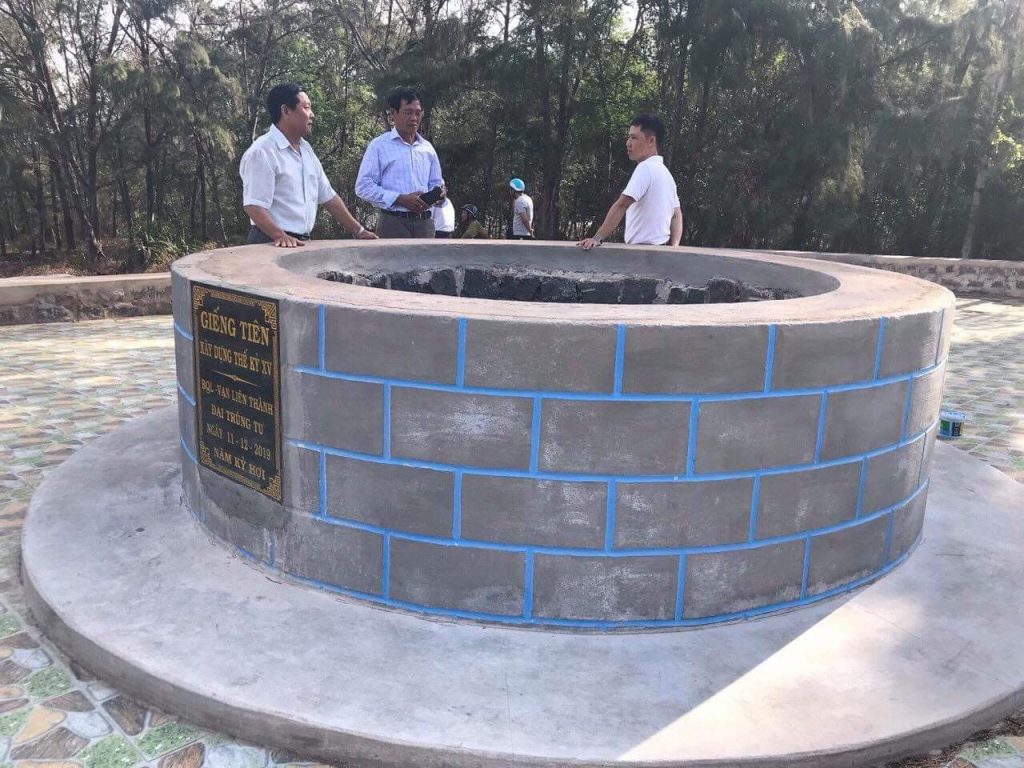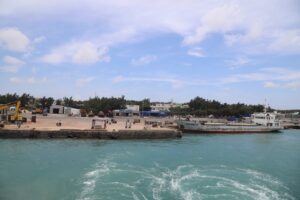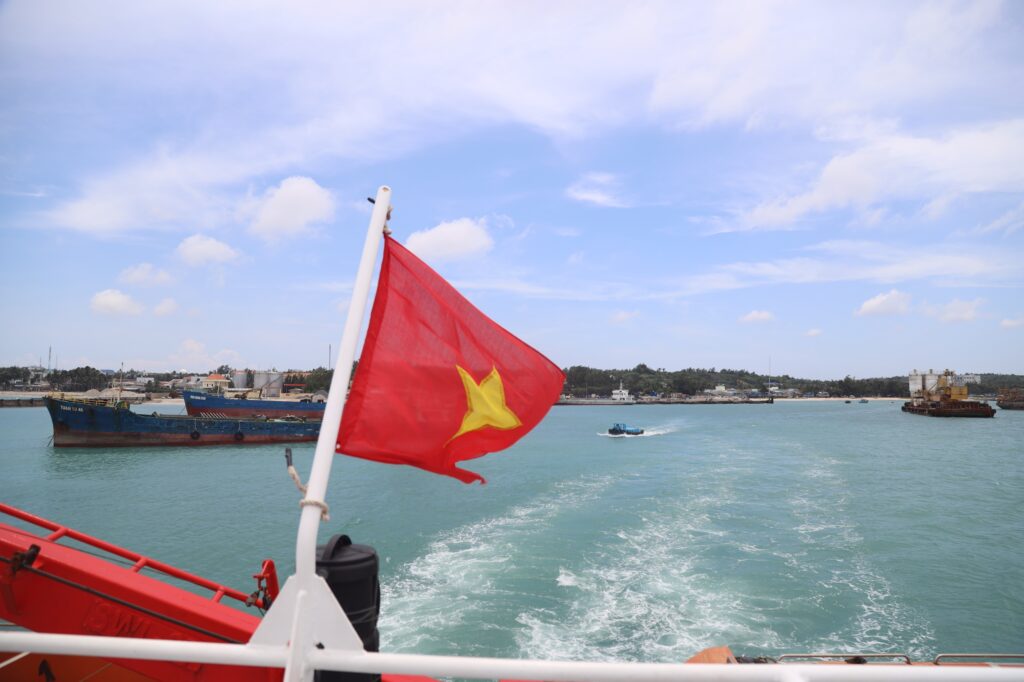Phú Quý, also known as Cù Lao Thu or Cù Lao Khoa Xứ (called Poulo Ce cir de Mer by the French), was renamed from Tổng Hạ to Tổng Phú Quý under Tuy Phong district, Ninh Thuận prefecture, Bình Thuận province since the 4th year of Thiệu Trị (1844) due to its abundant economic potential and the significant number of special products offered to the Huế Court.
Although it is an isolated island in the vast ocean, archaeological evidence indicates that the island was settled very early. While mining a type of stone called đá quánh, locals found large jar tombs containing tools such as axes, adzes, and finely crafted stone bracelets. These findings correspond with legends passed down that before continental settlers developed the island, the indigenous people, known as the Thượng, lived there by foraging and fishing along the coast. Throughout historical upheavals, Phú Quý has been a convergence point for many migrant groups from the mainland, comprising various ethnicities, with the Kinh people as the main group.
As sailing boat-building techniques advanced and ships ventured further offshore, many people from the mainland set foot on the island. Along with the remaining tombs, the legend of Princess Bàn Tranh indicates the presence of Cham people on the island.
Additionally, due to harsh feudal oppression and dissatisfaction with the monarchy, many sought refuge here to make a living. The Kinh people arrived on the island early as well. During the Trịnh–Nguyễn civil war (1627–1672), many fishermen from the central coastal provinces either fled conflicts or sought fishing grounds, and their boats, caught in fierce storms, were forced ashore the island.
Alongside the Kinh, some Hoa (Chinese) people integrated into Phú Quý’s community. In the 17th century, some Ming officials fled overseas after losing to the Qing dynasty. Fleets sailing southward included dozens that settled on Phú Quý. The Chinese there engaged in silk weaving and trading. Over time, some grew wealthy and moved to larger mainland cities, leaving only a few on the island.
As the population grew, social organization gradually developed. Under Nguyễn Phúc Khoát (1738–1765), Đàng Trong authorities organized the island into households (bạch bố), then teams (đội bạch bố), eventually forming hamlets and villages. Although population was not dense then, Phú Quý had 14 villages and one hamlet, each based on small fishing communities of about 10–12 men, often bearing their original locality names before settlement: Thoại Hải, Thế Hanh, Thế An, Hội Thiên, Hội Hưng, Hương Lăng, Mỹ Xuyên, Phú Ninh, An Hòa, Hải Châu, Thương Hải, Triều Dương, Hội An, Mỹ Khê, and the hamlet Quý Thạnh. From the Đồng Khánh era (starting 1886), the island was organized into 11 villages, and by 1930, after merging Phú Ninh into Phú Mỹ and Hương Lăng into Quý Thạnh, there were 9 villages remaining: Long Hải, Phú Mỹ, An Hòa, Hải Châu, Thương Hải, Quý Thạnh, Triều Dương, Mỹ Khê, and Hội An.
Currently, this island district covers about 16.4 km² within Bình Thuận Province, located 120 km southeast of Phan Thiết city. Besides the main island, Phú Quý is surrounded by smaller islands such as Hòn Đá Cao to the northwest, Hòn Đỏ to the northeast, and Hòn Tranh and Hòn Hải to the southwest. The island’s population is approximately 29,000 residents living in 3 island communes and 10 villages: Long Hải commune (with 4 villages: Tân Hải, Quý Hải, Đông Hải, Phú Long); Ngũ Phụng commune (3 villages: Phú An, Thương Châu, Quý Thạnh); and Tam Thanh commune (3 villages: Mỹ Khê, Hội An, Triều Dương).
During a survey in June 2018 on Phú Quý Island, we discovered 10 ancient wells scattered across the three communes.
Ancient wells in Tam Thanh commune
-
Well at Mr. Nguyễn Phới’s house: Located in alley 27/4, Mỹ Khê village, in front of a small single-story house, there is a well. When surveyed, several women were washing vegetables nearby, with basins of laundry and clothes drying on a line beside the well, showing it is still in use. The well’s low circular wall has a wooden round cover; the well’s interior is circular, built of stone with cement mortar. The water is clear but shallow. Locals and the owner say the well is very old, with unknown origins. Previously, it was a square well without mortar and had a square wooden frame at the bottom. About 10 years ago, it was rebuilt circularly and used by 7 to 10 households, now only Mr. Phới’s household uses it but it remains a community well. The water quality is excellent and the well never dries up, even during droughts when modern wells in the area run dry.
-
Well in Mr. Ngô Văn Minh’s yard: About 50 meters from the sea along a narrow alley, this ancient well has a newly built high square wall, stone-lined interior with a square wooden frame at the bottom. The interior stones appear rearranged. There are two plastic pump pipes indicating at least two households use it. Neighbors say it has been a communal well used by about ten households, with very good and never-drying water.
-
Well at Mr. Ngô Minh Hậu’s house: Located by the main road, about 200 meters from the sea, the well has a newly built brick wall without plaster. The interior is stone-lined but irregular due to large stones, with a square wooden frame at the bottom whose purpose is unknown. The water is very good and used for drinking; neighbors and fishermen still draw water from it following old tradition. The well has water year-round. Wall height and square sides are 100 cm; depth and water level unknown due to difficulty measuring.
-
Well in Mrs. Võ Thị Phúc’s yard, 79 Trần Hưng Đạo, Mỹ Khê village: Near the road, it has a square shape with newly built walls and clear square interior lined with stones and a wooden frame at the bottom. The well remains almost intact from its original form. There are three pump pipes and many containers around, showing many households still use it. The water is very good for drinking. Wall height 80 cm, side length 100 cm, depth 450 cm, water level 60 cm.
-
“Coconut Garden Well”: Located on the road to the sea near a large old coconut garden and a pier construction site, it has a water pump serving the construction. Locals say it was formerly used by the whole village and is old but repaired. The well’s interior stones are rectangular, carefully cut and shaped (unique among the wells). According to Dr. Edyta Roszko, the well is newly made but details are unclear. I believe this is an ancient well renovated with worked stones. The bottom is obscured by sand so the wooden frame (if any) is not visible. Mouth diameter 80 cm, depth 260 cm, water level 80 cm, stones about 50 x 30 cm.
Ancient wells in Long Hải commune
-
Well of Mr. Võ Thành Tâm: Located by the inter-commune road in Đông Hải village, it has a circular stone wall covered with concrete to prevent debris and accidents, so the interior cannot be inspected. According to locals, it is very old, once used by about 10 households. The interior is stone-built with a square wooden frame at the bottom. Diameter 154 cm, depth about 10 meters, water level 2–3 fathoms (1 fathom = 1.6 m) in rainy season, less in dry season.
-
Well at the village crossroads: About 500 m toward the commune center, this circular cement-walled well has no cover and is still used by Mr. Nguyễn Hiểu’s family, considered a communal well. It is very old and used by about 15 households with very good water. The road where it is located is planned for expansion, threatening the well’s existence, posing a difficult conflict between development and conservation. Wall height 75 cm, depth 420 cm.
-
Bàn Tranh Well: Located in Long Hải commune center within the spacious and elevated grounds of the newly built Princess Bàn Tranh Temple. At the southeast side of the temple courtyard, near the steps, is an ancient well partly covered by the construction, shaped like a half-moon but with a round cement-lined interior. The well was recently restored. Legend says Princess Bàn Tranh, daughter of the Champa king, was exiled to the island for disobeying the king’s marriage orders. She taught locals weaving and farming, including growing delicious watermelons (still known today), similar to the Mai An Tiêm watermelon legend in northern Vietnam. The temple is newly rebuilt but the worship site is very old. We speculate that a Cham worship structure existed here earlier, continued with Vietnamese reverence. The ancient well in the temple yard may date back to the Champa period, but further evidence is needed.
-
Tiên Well: On the road from Long Hải center to the wind power area, about 50 meters left of Long Hải Secondary School at the hill slope, is a large ancient well called Tiên Well. It is classified as a










